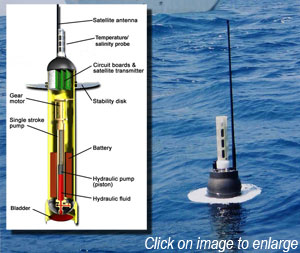
| Buoyancy | ||
| [ Images | PDF: Part I & Part II] | ||
| What keeps an ocean liner afloat? What determines if ocean water masses will sink or rise? Why do you need a scuba buoyancy compensator (BC) when diving? The answer to all these questions is buoyancy. To understand how buoyancy works, begin with the bathtub like Archimedes who is credited for discovering the principle named after him*. When you enter a filled bathtub, the water level rises. This is because your body displaces water, causing it to move elsewhere. The amount of water your body displaces equals the volume of your body that is immersed below the water level. |
|
|
*Archimedes’ Principle of Buoyancy
|
||
In deeper water, the weight of a body pushes it downwards (due to gravity) while the weight of displaced water applies a force upwards. If the upward and downward forces are equal (i.e., body weight equals the weight of the displaced water), an object will neither sink nor rise. If an object's weight is greater than the weight of the water it displaces, it will sink. If it is less, the object will float. Thus the key to keeping a ship afloat -- whether it is made out of wood, steel, or concrete -- is to make it displace a volume of water that weighs at least as much as the vessel itself. (Image from the Smithsonian Institution)
What can buoyancy tell us about the ocean?
|
||
Buoyancy is one of the dominant forces in ocean dynamics. Interestingly, buoyancy is also used to better understand the ocean itself. Engineers & oceanographers have designed innovative technologies that use buoyancy to propel instruments through ocean waters, including autonomous underwater vehicles. For example, buoyancy-driven gliders and floats carry a variety of sensors to measure temperature, salinity, and biochemistry. These instruments can sample the water column by changing their density, thus altering the buoyant forces applied to them. By pumping a fluid into/out of an incompressible reservoir (e.g., a bottle) to one that is compressible (e.g., an external balloon or "bladder"), the vehicle changes its volume while its mass remains constant. The resulting change in density causes the instrument to shift its depth in the ocean. The image above shows a cross-sectional view and photographic image of an Argo float. Argo is a global array of 3,000 free-drifting profiling floats that measures the temperature and salinity of the upper 2000 meters of the ocean. (Click here to learn more about how Argo floats work.)
How might this workshop benefit my students?
The eight activities depicted below were designed to introduce students to the concept of buoyancy by immersing objects of various volumes and masses into fresh and salt water, making predictions on whether objects will float and sink and testing their predictions. Full details and explanations of stations are available by clicking here (3.0 MB PDF file).
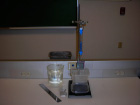 |
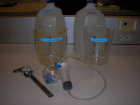 |
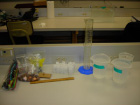 |
|
Click on any image to see a larger version |
|||
 |
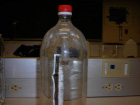 |
 |
|


